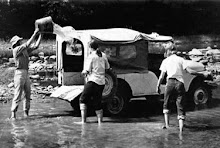Below are excerpts from an essay written by Marielle, Fall Courier 2009. She came through the Dartmouth Partner in Community Service at Dartmouth College. Names have been changed to protect identities.
I was somewhat nervous at first to volunteer with Hospice, but I ended up looking forward to it instead– the warmth of all the office staff, the genuine thankfulness of all the patients that we saw, and the nature of the work itself. I enjoyed my visits with one older patient under Hospice care. The patient reminded me of my grandparents, the patient was 89 but looked no older than 65. The patient was able-bodied though frail, still quite active, and had end-stage heart disease. I was shown family photographs and told about how they had sat beside their spouse who had had a stroke and was not able to move, not able to talk, or acknowledge their presence for three years– three whole years. That was devotion. I could not imagine how hard that must have been. And how unusual that seemed to me, in a world where people will sometimes leave fading relatives to the care of a nursing home or other facility.
The birth was a unique experience also; we received the call at 7:30 in the morning from Mary, one of the midwives, informing us that a woman one of the other couriers had visited in the hospital a few days earlier was in labor, and to come down to the hospital if we wanted to see a birth. Me and Katie (the other courier) got ready and were at the hospital by 8. “Sandra”, the first time mother, had just been given an epidural anesthetic. Apparently the labor had been going on since 11 pm the night before. In her birth plan she had not wanted any anesthetics at all, but after 8 hours of painful contractions, she had asked four times for an epidural and received it. She was smiling and cheerful when we entered the room, and her husband was asleep on the pull out chair by the window, having been up coal mining early the day before and up all night with his wife. I saw firsthand why FNS prefers to do noninvasive births, as natural as possible; once one interferes with the birthing process, one often has to continue interfering, and problems can arise. For example, because Sandra had been given the epidural so early, her contractions slowed down and she was only dilated to about 4 centimeters by one o’clock (a woman starts pushing once she is fully dilated and 100% effaced, meaning her cervix is 10 centimeters). Thus, the midwife Jane (who had taken over for Mary) had to break her water, and administer a small amount of the drug Pitocin, which makes the contractions come harder and faster. Luckily, this combination eventually worked, and Sandra's contractions came closer together, and her cervix became fully dilated at around 6 or 6:30 pm. Sometimes, however, a woman must have a c-section due to failure to progress with the labor, which can make a woman who had really wanted to have her baby the natural way feel like a failure or can do unnecessary harm to the woman’s body, and make it more complicated for her in future pregnancies.
Once Sandra was ready to push, the actually pushing part for her was so short! Maybe half an hour, but it felt shorter, especially in comparison to the long wait. She was a little over 5 feet tall and her baby was 9 lbs. 5 oz, a big baby boy. The midwife had to rush to put her gloves on in time. The head was there, you could see it coming, and then you could see the hair, and then boom! The midwife reached in at the next push and pulled him out, his head and shoulders and body all came at once, and they placed him on his mother’s belly so that they could each get their first looks at one another. He was adorable.
skip to main |
skip to sidebar

everything courier
About the Blog
This blog is dedicated to Everything Courier - a forum to process and share our daily medical and community based adventures.
By nature of the program and working directly with people, each Frontier Nursing Service (FNS) Courier will have a unique series of experiences.
Read on to get a taste of the courier lifestyle, rural medicine, modern Appalachian culture, and some good story telling.
By nature of the program and working directly with people, each Frontier Nursing Service (FNS) Courier will have a unique series of experiences.
Read on to get a taste of the courier lifestyle, rural medicine, modern Appalachian culture, and some good story telling.
About Me

- fns courier
- Couriers came about when Mary Breckinridge started the Frontier Nursing Service at the beginning of the 20th Century. The courier program began in 1928 to provide non-medical individuals exposure to rural communities, service work, and the FNS mission. Today, the purpose is much the same. I guess the biggest difference is now that midwives have cars and hospitals and there are not all the horses to look after (that was their original mode of transportation), there's a lot more time for other community outreach work.